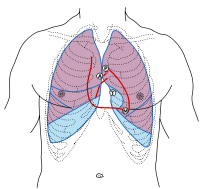
Photo from wikipedia
Abstract Active Shape Models (ASMS) play an important role in model based medical image analysis. They utilize point distribution models (PDMs) in which a priori information is encoded into a… Click to show full abstract
Abstract Active Shape Models (ASMS) play an important role in model based medical image analysis. They utilize point distribution models (PDMs) in which a priori information is encoded into a template so that the objects to be detected can be represented with a fixed topology. One key element in 3D-ASM is the image intensity model (IIM), which is investigated in this work. We propose a hybrid approach to automatically construct 3D-ASM Intensity Models for the left ventricle. To train the IIM, CNN is adopted to obtain the initial shape for 3D-ASM, distance maps for endo and epicardial contours from ground truth are derived, and using PDM, training shapes can be obtained. The training shapes and cardiac images are then used to train an IIM. 1200 cardiac MRI cases from Hubei Cancer Hospital were used in this study. By comparing point-to-surface errors against a proper gold standard, it demonstrates that large-scale cardiac MRIs can be segmented by 3D models trained under this scheme with fair accuracy. Clinical parameters are calculated using the Bland-Altman analysis, and thus we yield biases of 4.8 ml, 2.19 ml, 2.59 ml, 0.96%, 0.69 g and -2.67 g for LVEDV (LV End-diastolic Volume), LVESV (LV End-systolic Volume), LVSV (LV Stroke volume), LVEF (LV Ejection Fraction), LVM-DP (LV mass in diastolic phase) and LVM-SP (LV mass in systolic phase), respectively.
Journal Title: Neurocomputing
Year Published: 2020
Link to full text (if available)
Share on Social Media: Sign Up to like & get
recommendations!